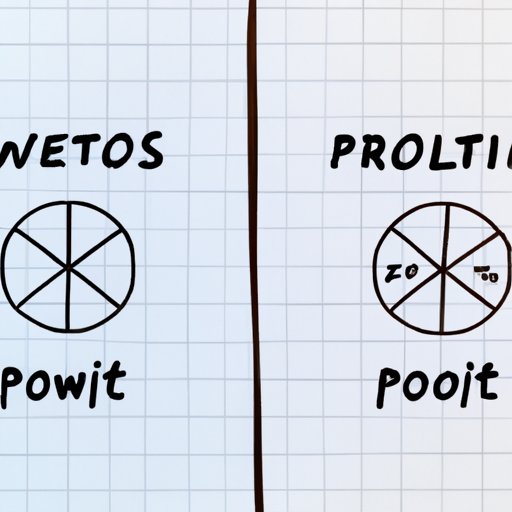
Introduction
If you are someone who struggles with math, particularly with solving proportions, then you are not alone. However, mastering proportions is a crucial skill that can be applied to many other areas of math. Whether you are working on a homework assignment, preparing for a test, or simply trying to improve your math skills, this comprehensive guide will provide you with step-by-step instructions, tips, and tricks for solving any proportion problem.
Mastering Proportions: A Step-by-Step Guide to Solving Any Proportion Problem
Before diving into the methods of solving proportion problems, let’s first define what proportions are. In math, proportions are used to describe the relationship between two or more numbers. For example, if you have four boys and six girls in a classroom, the ratio of boys to girls is 4:6, which can be simplified to 2:3.
One method of solving proportion problems is through cross-multiplication. This involves multiplying the numerator of one ratio by the denominator of the other ratio and setting them equal to each other. For example, if you have the proportion 4/5 = x/20, you would cross-multiply and get 4*20 = 5x, which simplifies to 80 = 5x. Solving for x, you get x = 16.
Another method is the use of equivalent ratios. This involves finding a ratio equivalent to the given proportion and then solving the problem using cross-multiplication or other methods. For example, if you have the proportion 5/7 = x/28, you can first simplify the fraction by multiplying both numerator and denominator by 4 to get 20/28 = x. Then, solving for x, you get x = 20*28/28, which simplifies to x = 20.
To better understand these methods, let’s walk through a few practice problems.
Practice problem 1: Solve the proportion: 3/4 = 6/x using cross-multiplication.
Solution: Cross-multiplying, we have 3x = 24, which simplifies to x = 8.
Practice problem 2: Solve the proportion: 2/3 = x/15 using equivalent ratios.
Solution: Finding an equivalent ratio by multiplying both numerator and denominator by 5, we get 10/15 = x. Solving for x, we get x = 10*15/15, which simplifies to x = 10.
Proportions Solved: Tips, Tricks, and Examples to Improve Your Math Skills
Recognizing proportion problems can be tricky, but there are a few tips you can follow to make it easier. First, look for a comparison or relationship between two or more numbers. Then, check to see if the problem can be simplified into a ratio. If so, you have a proportion problem.
There are also some shortcuts and tricks you can use to solve proportion problems quickly. For example, if you have a proportion with a percentage, you can convert it to a fraction by dividing the percentage by 100. Similarly, you can convert ratios to fractions by dividing the numerator by the denominator.
Let’s try a few more practice problems.
Practice problem 1: Write 25% as a fraction and solve the proportion 25% = x/80.
Solution: 25% can be written as 1/4. Using cross-multiplication, we get 1*80 = 4x, which simplifies to x = 20.
Practice problem 2: Simplify the ratio 42:56.
Solution: Dividing both numerator and denominator by 14, we get 3:4.
The ABCs of Proportions: Simplifying the Complex World of Math Equations
It’s important to understand the terminology associated with proportions in order to solve proportion problems accurately. Terms like ratio, proportion, and percent can be confusing, but with a little practice, they can be easy to understand.
To convert between different terms, you can use the following formulas:
Ratio to percentage: divide the numerator by the denominator and multiply by 100.
Percentage to ratio: divide the percentage by 100 and simplify the resulting fraction.
Ratio to proportion: write the ratio as a fraction and simplify.
Proportion to ratio: write the proportion as an equivalent ratio.
Let’s practice converting between terms.
Practice problem 1: What is the ratio equivalent to 60%?
Solution: Converting from percentage to ratio, we divide 60 by 100, which gives us 3/5.
Practice problem 2: Convert the ratio 4:7 to a proportion.
Solution: To convert a ratio to a proportion, we write it as a fraction and simplify. Therefore, 4/7 is the proportion.
Solving Proportions Made Easy: Expert Advice to Help Conquer Your Next Math Test
When solving proportion problems, it’s important to avoid common mistakes such as forgetting to simplify fractions, mixing up numerator and denominator, or forgetting to convert between terms. To avoid these mistakes, take your time and double-check your work before moving on to the next problem.
To improve your test-taking success, be sure to read each problem carefully and identify the type of proportion problem before attempting to solve it. Practice using different methods and formulas to solve proportion problems and make note of any shortcuts or tricks that work best for you.
Let’s practice a few final problems.
Practice problem 1: Solve the proportion 9/15 = x/25.
Solution: Cross-multiplying, we get 9*25 = 15x, which simplifies to x = 15.
Practice problem 2: Write 60% as a ratio.
Solution: Dividing 60 by 100 and simplifying, we get 3:5.
Breaking Down Proportions: A Comprehensive Guide to Understanding and Solving Math Problems
In summary, proportions can be intimidating, but with practice and understanding of different methods and formulas, anyone can solve them easily. It’s important to recognize proportion problems, use shortcuts and tricks whenever possible, and understand the terminology associated with proportions.
Remember to practice consistently and seek additional resources if needed. As you continue to practice, you will gain confidence and become a master at solving any proportion problem that comes your way.




